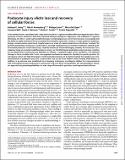Files in this item
Podocyte injury elicits loss and recovery of cellular forces
Item metadata
| dc.contributor.author | Haley, Kathryn | |
| dc.contributor.author | Kronenberg, Nils Michael | |
| dc.contributor.author | Liehm, Philipp | |
| dc.contributor.author | Elshani, Mustafa | |
| dc.contributor.author | Bell, Cameron | |
| dc.contributor.author | Harrison, David James | |
| dc.contributor.author | Gather, Malte Christian | |
| dc.contributor.author | Reynolds, Paul Andrew | |
| dc.date.accessioned | 2018-07-03T10:14:03Z | |
| dc.date.available | 2018-07-03T10:14:03Z | |
| dc.date.issued | 2018-06-27 | |
| dc.identifier | 253025665 | |
| dc.identifier | 2a145dc3-5ac1-41f2-a3bb-7f0cdd8658ca | |
| dc.identifier | 85049212201 | |
| dc.identifier | 000443175500014 | |
| dc.identifier.citation | Haley , K , Kronenberg , N M , Liehm , P , Elshani , M , Bell , C , Harrison , D J , Gather , M C & Reynolds , P A 2018 , ' Podocyte injury elicits loss and recovery of cellular forces ' , Science Advances , vol. 4 , no. 6 , eaap8030 . https://doi.org/10.1126/sciadv.aap8030 | en |
| dc.identifier.issn | 2375-2548 | |
| dc.identifier.other | ORCID: /0000-0001-8738-1245/work/46362067 | |
| dc.identifier.other | ORCID: /0000-0002-4857-5562/work/47136469 | |
| dc.identifier.other | ORCID: /0000-0001-9041-9988/work/64034292 | |
| dc.identifier.uri | https://hdl.handle.net/10023/14836 | |
| dc.description | K.E. Haley was funded by a University of St. Andrews 600th Anniversary PhD Scholarship. M.C.G. acknowledges support by the Human Frontiers Science Program (RGY0074/2013), the Scottish Funding Council (via SUPA), EPSRC (EP/P030017/1) and the ERC Starting Grant ABLASE (640012). D.J.H. was supported by NHS Lothian. M.C.G. and P.A.R. acknowledge support by the BBSRC (BB/P027148/1). | en |
| dc.description.abstract | In the healthy kidney, specialized cells called podocytes form a sophisticated blood filtration apparatus that allows excretion of wastes and excess fluid from the blood while preventing loss of proteins such as albumin. To operate effectively, this filter is under substantial hydrostatic mechanical pressure. Given their function, it is expected that the ability to apply mechanical force is crucial to the survival of podocytes. However, to date podocyte mechanobiology remains poorly understood, largely due to a lack of experimental data on the forces involved. Herein, we perform quantitative, continuous, non-disruptive and high-resolution measurement of the forces exerted by differentiated podocytes in real time using a recently introduced functional imaging modality for continuous force mapping. Using an accepted model for podocyte injury, we find that injured podocytes experience near complete loss of cellular force transmission, but that this is reversible under certain conditions. The observed changes in force correlate with F-actin rearrangement and reduced expression of podocyte-specific proteins. By introducing robust and high-throughput mechanical phenotyping and by demonstrating the significance of mechanical forces in podocyte injury, this research paves the way to a new level of understanding of the kidney. In addition, we integrate cellular force measurements with immunofluorescence and perform continuous long-term force measurements of a cell population, which has not been feasible with established force mapping techniques. As such, our approach has general applicability to a wide range of biomedical questions involving mechanical forces. | |
| dc.format.extent | 9 | |
| dc.format.extent | 3686299 | |
| dc.language.iso | eng | |
| dc.relation.ispartof | Science Advances | en |
| dc.subject | RB Pathology | en |
| dc.subject | DAS | en |
| dc.subject | BDC | en |
| dc.subject | R2C | en |
| dc.subject.lcc | RB | en |
| dc.title | Podocyte injury elicits loss and recovery of cellular forces | en |
| dc.type | Journal article | en |
| dc.contributor.sponsor | EPSRC | en |
| dc.contributor.sponsor | European Research Council | en |
| dc.contributor.sponsor | BBSRC | en |
| dc.contributor.institution | University of St Andrews. School of Medicine | en |
| dc.contributor.institution | University of St Andrews. School of Physics and Astronomy | en |
| dc.contributor.institution | University of St Andrews. Cellular Medicine Division | en |
| dc.contributor.institution | University of St Andrews. Biomedical Sciences Research Complex | en |
| dc.identifier.doi | 10.1126/sciadv.aap8030 | |
| dc.description.status | Peer reviewed | en |
| dc.date.embargoedUntil | 2018-06-27 | |
| dc.identifier.grantnumber | EP/P030017/1 | en |
| dc.identifier.grantnumber | 640012 | en |
| dc.identifier.grantnumber | BB/P027148/1 | en |
This item appears in the following Collection(s)
Items in the St Andrews Research Repository are protected by copyright, with all rights reserved, unless otherwise indicated.

